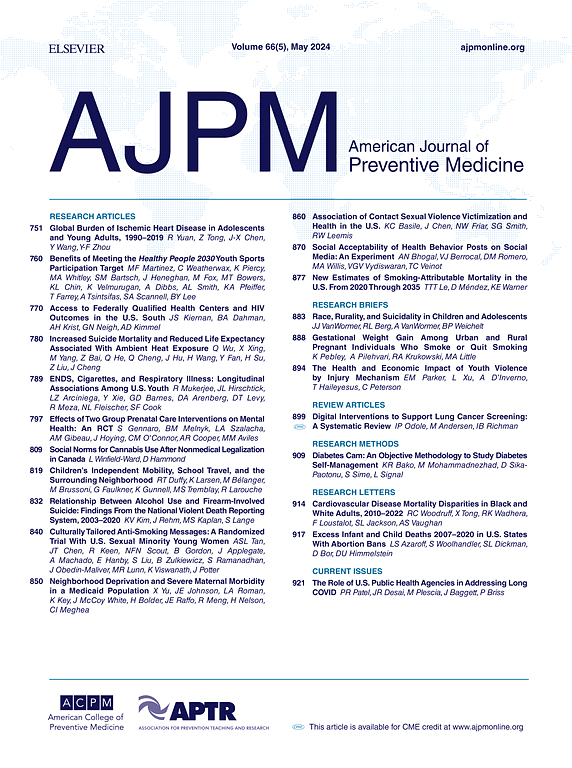2021-2022 年美国的大麻使用、使用障碍和工作场所缺勤率。
IF 4.5
2区 医学
Q1 MEDICINE, GENERAL & INTERNAL
引用次数: 0
摘要
导言:吸食大麻和大麻使用障碍(CUD)与不良的社会心理结果有关,但它们对工作场所缺勤率的影响仍鲜为人知。此外,很少有研究探讨 CUD 严重程度的作用。本研究旨在通过研究吸食大麻的经常性、频率、CUD 严重程度和工作场所缺勤率之间的关联来填补这些空白:方法:分析了 2021 年至 2022 年美国全国药物使用和健康调查(N=46,499)中具有美国代表性的≥18 岁全职就业成人样本的横截面数据。使用负二项回归法评估了大麻使用频率、上月大麻使用频率、CUD 严重程度和工作场所缺勤率(以自我报告的过去 30 天内因病/因伤缺勤天数和旷工天数来衡量)之间的关联,并对社会人口特征和其他药物使用情况进行了调整。对 2023-2024 年的数据进行了分析:据估计,15.9% 的全职就业成年人在过去一个月使用过大麻,其中 6.5% 符合 CUD 标准。过去一个月吸食大麻(与终生不吸食大麻相比)、过去一个月更频繁吸食大麻(与过去一个月不吸食大麻相比)以及每种程度的 CUD(与不 CUD 相比)都与因病/因伤缺勤和旷工的发生率增加有关,CUD 严重程度与旷工之间存在剂量反应关系(轻度:调整后事件发生率比 [aIRR]=1.60[95%置信区间[CI]=1.24,2.08];中度:aIRR=1.98 [95% CI=1.50,2.61]);重度(aIRR=2.87 [95% CI=2.12,3.88]):结论:近期频繁使用大麻和 CUD 的人更容易在工作场所缺勤。研究结果支持执行工作场所毒品预防和治疗政策。本文章由计算机程序翻译,如有差异,请以英文原文为准。
Cannabis Use, Use Disorder, and Workplace Absenteeism in the U.S., 2021–2022
Introduction
Cannabis use and cannabis use disorder (CUD) are associated with adverse psychosocial outcomes, but their impact on workplace absenteeism remains poorly understood. Moreover, few studies have examined the role of CUD severity. This study aims to address these gaps by examining the associations between cannabis use recency, frequency, CUD severity, and workplace absenteeism.
Methods
Cross-sectional data from a U.S. representative sample of full-time employed adults aged ≥18 from the 2021 to 2022 National Survey on Drug Use and Health (N=46,499) were analyzed. The associations between cannabis use recency, past-month cannabis use frequency, CUD severity, and workplace absenteeism (measured by self-reported number of missed days due to illness/injury and skipped work in the last 30 days) were evaluated using negative binomial regression, adjusting for sociodemographic characteristics and other substance use. Data were analyzed in 2023–2024.
Results
An estimated 15.9% of full-time employed adults used cannabis in the past month, with 6.5% meeting CUD criteria. Past-month cannabis use (compared to no lifetime use), more frequent past-month cannabis use (compared to no use in the past month), and each level of CUD (compared to no CUD) were associated with increased incidence of both missing work due to illness/injury and skipping work, with a dose-response relationship observed between CUD severity and skipping work (mild: adjusted incident rate ratio [aIRR]=1.60 [95% confidence interval [CI]=1.24, 2.08]; moderate: aIRR=1.98 [95% CI=1.50, 2.61]); severe (aIRR=2.87 [95% CI=2.12, 3.88]).
Conclusions
Individuals with recent and frequent cannabis use and CUD are disproportionately prone to workplace absenteeism. Results support the enforcement of workplace drug prevention and treatment policies.
求助全文
通过发布文献求助,成功后即可免费获取论文全文。
去求助
来源期刊

American Journal of Preventive Medicine
医学-公共卫生、环境卫生与职业卫生
CiteScore
8.60
自引率
1.80%
发文量
395
审稿时长
32 days
期刊介绍:
The American Journal of Preventive Medicine is the official journal of the American College of Preventive Medicine and the Association for Prevention Teaching and Research. It publishes articles in the areas of prevention research, teaching, practice and policy. Original research is published on interventions aimed at the prevention of chronic and acute disease and the promotion of individual and community health.
Of particular emphasis are papers that address the primary and secondary prevention of important clinical, behavioral and public health issues such as injury and violence, infectious disease, women''s health, smoking, sedentary behaviors and physical activity, nutrition, diabetes, obesity, and substance use disorders. Papers also address educational initiatives aimed at improving the ability of health professionals to provide effective clinical prevention and public health services. Papers on health services research pertinent to prevention and public health are also published. The journal also publishes official policy statements from the two co-sponsoring organizations, review articles, media reviews, and editorials. Finally, the journal periodically publishes supplements and special theme issues devoted to areas of current interest to the prevention community.
 求助内容:
求助内容: 应助结果提醒方式:
应助结果提醒方式:


